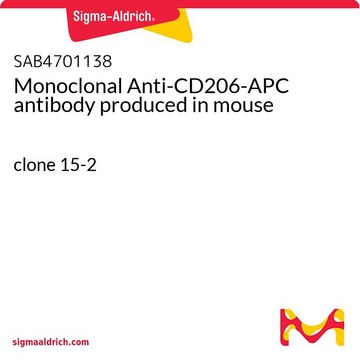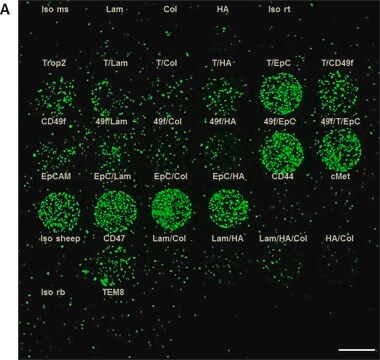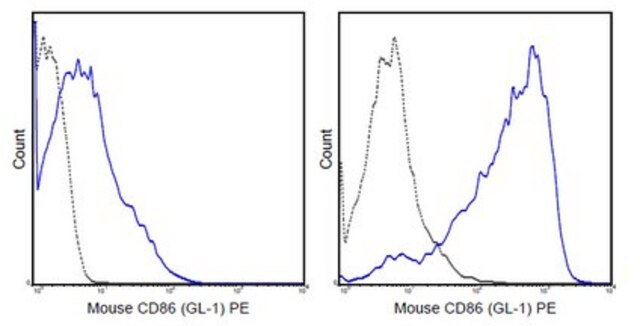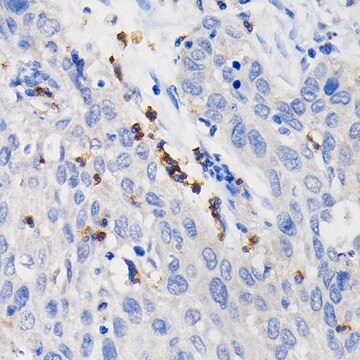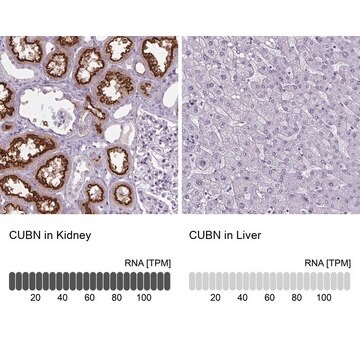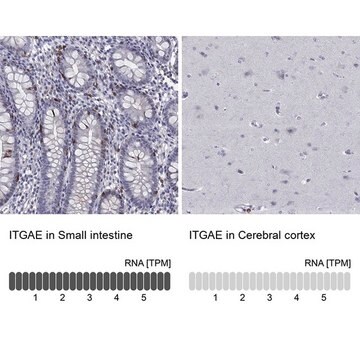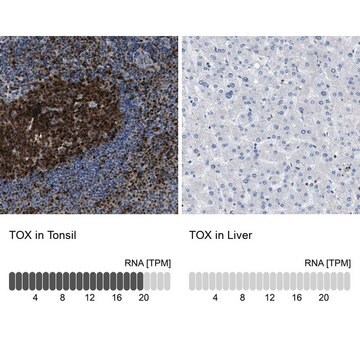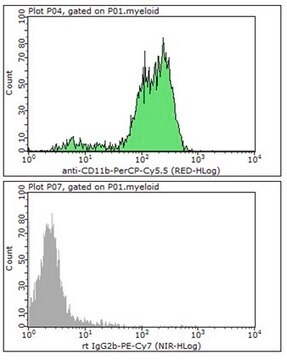SAB4700144
Monoclonal Anti-CD86 antibody produced in mouse
clone BU63, purified immunoglobulin, buffered aqueous solution
Iniciar sesiónpara Ver la Fijación de precios por contrato y de la organización
About This Item
Código UNSPSC:
12352203
NACRES:
NA.41
Productos recomendados
origen biológico
mouse
Nivel de calidad
conjugado
unconjugated
forma del anticuerpo
purified immunoglobulin
tipo de anticuerpo
primary antibodies
clon
BU63, monoclonal
Formulario
buffered aqueous solution
reactividad de especies
human
concentración
1 mg/mL
técnicas
flow cytometry: suitable
isotipo
IgG1
Nº de acceso NCBI
Nº de acceso UniProt
Condiciones de envío
wet ice
temp. de almacenamiento
2-8°C
modificación del objetivo postraduccional
unmodified
Información sobre el gen
human ... CD86(942)
Descripción general
The antibody BU63 reacts with CD86 (B7-2), a 70 kDa type I transmembrane glycoprotein of immunoglobulin supergene family, expressed on professional antigen-presenting cells, such as dendritic cells, macrophages or activated B lymphocytes.
Inmunógeno
B-lymphoblastoid cell line ARH 77
Aplicación
The reagent is designed for Flow Cytometry analysis. Suggested working dilution for Flow Cytometry is 5 μg/mL of sample. Indicated dilution is recommended starting point for use of this product. Working concentrations should be determined by the investigator.
Características y beneficios
Evaluate our antibodies with complete peace of mind. If the antibody does not perform in your application, we will issue a full credit or replacement antibody. Learn more.
Forma física
Solution in phosphate buffered saline, pH 7.4, with 15 mM sodium azide.
Cláusula de descargo de responsabilidad
Unless otherwise stated in our catalog or other company documentation accompanying the product(s), our products are intended for research use only and are not to be used for any other purpose, which includes but is not limited to, unauthorized commercial uses, in vitro diagnostic uses, ex vivo or in vivo therapeutic uses or any type of consumption or application to humans or animals.
¿No encuentra el producto adecuado?
Pruebe nuestro Herramienta de selección de productos.
Código de clase de almacenamiento
10 - Combustible liquids
Punto de inflamabilidad (°F)
Not applicable
Punto de inflamabilidad (°C)
Not applicable
Elija entre una de las versiones más recientes:
¿Ya tiene este producto?
Encuentre la documentación para los productos que ha comprado recientemente en la Biblioteca de documentos.
Grant R Kolar et al.
Blood, 109(6), 2545-2552 (2006-11-30)
We have identified a novel mature human B-cell subpopulation in the human tonsil that has characteristics of both naive B cells and germinal center B cells including the expression of activation-induced cytidine deaminase (AID), which is essential for the process
Christiane S Heilingloh et al.
The Journal of general virology, 95(Pt 6), 1366-1375 (2014-03-20)
Mature dendritic cells (mDCs) are the most potent antigen-presenting cells known today, as they are the only antigen-presenting cells able to induce naïve T-cells. Therefore, they play a crucial role during the induction of effective antiviral immune responses. Interestingly, the
Laura J Vella et al.
Cancer immunology research, 2(4), 351-360 (2014-04-26)
Combination therapy with BRAF and MEK inhibition is currently in clinical development for the treatment of BRAF-mutated malignant melanoma. BRAF inhibitors are associated with enhanced antigen-specific T-lymphocyte recognition in vivo. Consequently, BRAF inhibition has been proposed as proimmunogenic and there
Jingjuan Meng et al.
International journal of biological macromolecules, 69, 388-392 (2014-06-20)
The seaweed Laminaria japonica has been investigated in a laboratory research for its medical significance and LJP has been purified now. The objective of present study was to look at effect of LJP on structural, phenotypic and functional maturation of
Adrienne Müller et al.
International journal of cardiology, 174(3), 503-515 (2014-05-20)
Myocardial infarction and stroke are the life-threatening consequences after plaque rupture in coronary or carotid arteries. Positron emission tomography employing [(18)F]fluorodeoxyglucose can visualize plaque inflammation; however, the question remains whether this is specific for plaque vulnerability. The pathophysiology of vulnerable
Global Trade Item Number
| Número de referencia del producto (SKU) | GTIN |
|---|---|
| SAB4700144-100UG | 4061832706092 |
Nuestro equipo de científicos tiene experiencia en todas las áreas de investigación: Ciencias de la vida, Ciencia de los materiales, Síntesis química, Cromatografía, Analítica y muchas otras.
Póngase en contacto con el Servicio técnico